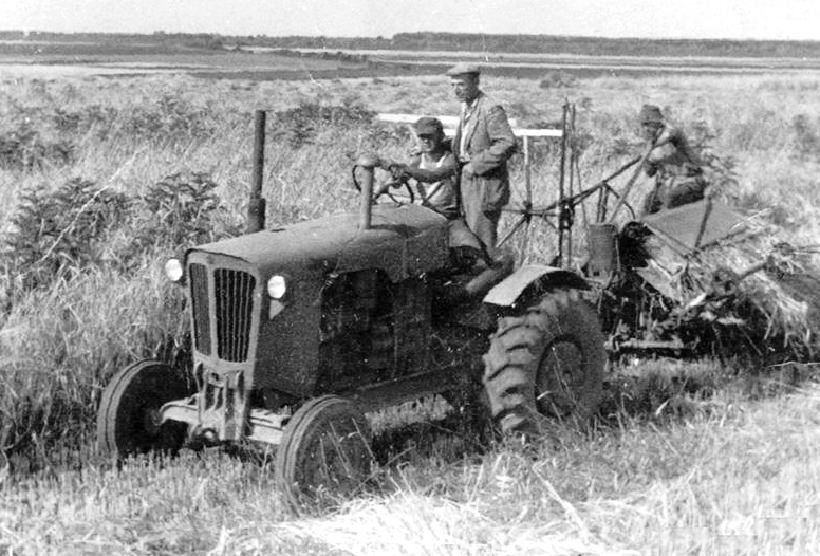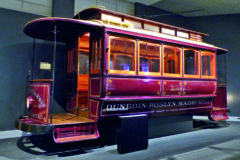1940s Zadrugar T-08 tractor
Posted by Chris Graham on 1st June 2021
The 1940s Zadrugar T-08 tractor grew out of Yugoslavia’s post-war break-away from the USSR, as Aleksandar Vidojkovic and Tony Hoyland explain.

A colour postcard featuring a stylised image of the 1940s Zadrugar T-08 tractor.
During the mid-1940s, 70% of Yugoslavia’s population was living in rural areas. In 1945, out of about 255,000 km² of the country’s total area, 318,000 ha of arable land was in the social ownership of socialist Yugoslavia. Post-war, there was an urgent need for mechanisation in agriculture and, with help from UNRRA (United Nations Relief and Rehabilitation Administration), around 6,500 American-made tractors had been obtained by the end of the program, in 1947.
Stalin vs Tito
As a backdrop to this situation, a meeting between the Supreme Commander of the People’s Liberation Army of Yugoslavia, Marshal Josip Broz Tito, and Joseph Vissarionovich Stalin, Secretary-General of the Communist Party of the Soviet Union, took place in September 1944, in Moscow. It was then that close co-operation was established between the leaders of the two communist countries, strengthened by Yugoslavia’s complete deviation from its western allies, because of the Trieste crisis in mid-1945.
However, conflicts soon arose between Stalin and Tito over several issues. By 1948, Yugoslavia broke away, losing the political and economic support of the USSR and other allied socialist countries. Among them were those with a history of tractor production, which meant that the procurement of tractors manufactured in socialist countries was no longer an option.

One of tractor designer, Stevan Mihajlović’s conceptual sketches.
Home-grown prototypes
To begin production of tractors in the country, the Economic Council of the Government of the Federal People’s Republic of Yugoslavia, entered negotiations with the Hungarian Tractor Industry (HSCS), but these failed because of a Cominform Resolution. At the end of 1948, the General Directorate of the Federal Motor Industry received an order to design tractors of entirely domestic make. But the only real production capacity, given such brief notice, was the IMR (Industrija Motora Rakovica – Rakovica Motor Industry), which had been formed in 1927.
The deadline by which to produce a tractor prototype was the Zagreb Fair, which opened on September 17th, 1948. This project was given the code name ‘T-08’ (Tractor-1948). The leading engineers of the construction bureaus of the Federal Motor Industry General Directorate and IMR, were in charge of the construction. A wheel concept with a conservative, ‘U’ chassis solution was chosen with normal profiles, which resulted in a relatively large mass of about 2.5 tonnes (with weights). The gearbox had three forward and reverse gears, as well as a two-stage reducer. The tractor had a connecting shaft, a pulley, tow bar and towing hook at the rear. But a hydraulic carrying device for connecting tools wasn’t included.
A race against time
As a solution, a six-cylinder sidevalve (SV) petrol engine from the Praga RN truck, the IMR Pionir (made in IMR), was chosen as the propulsion unit. A large percentage of it was manufactured domestically, with nominal, 3.5-litre volume and power reduced – by limiting the number of revolutions – to 45hp, whose operation was controlled via a centrifugal speed controller. It was petrol-powered and, with fuel consumption of 9l/h at maximum load, it was extremely uneconomical compared to those powered by crude oil, heavy oil and kerosene.

Road tests were conducted with a load of approximately eight tons, over hilly terrain around the factory, with a rising slope of up to 20%.
With the deadline to beat, the assembly of three prototypes was completed by the end of August 1949 at IMR. On September 11th, 1949, all three were presented to Josip Broz Tito. The tractors shown were the Udarnik (Hero of labour) with multiple uses, the Zadrugar (Cooperative) with a cabin intended primarily for towing cargo in traffic on regulated roads and for towing implements (max speed 27kph), and the Rakovica with pneumatic tyres on rear wheels (alternatively steel) intended primarily for fieldwork.
Propaganda weapons
The tractor prototypes were the stars at the Zagreb Fair, where they served as a weapon in the fierce propaganda war waged with the Cominform member countries, but also in forming domestic public opinion. These were very different times, and the General Director of IMR, Ivan Andrijevic, was quoted at a reception with Tito as saying: “From the moment when the attacks on our country began, we have doubled our efforts… We, and all our people, considered it to be the best answer to those who assume the truth to be untrue. We, Comrade Tito, are bound to you by blood!”

The first 50 tractors of the Zadrugar series took part in the traditional May Day parade through the streets of Belgrade, in 1951.
Of the three prototypes, only the version without a cabin, with universal purpose, entered production, and it was renamed Zadrugar. The first 50 of the series took part in the traditional May Day parade in Belgrade, in 1951, after which they were handed over to customers – agricultural co-operatives across the country.
By the end of production in mid-1954, 2,520 tractors of this type had been produced. Besides the political and propaganda effects, and based on the production numbers, the tractors undoubtedly also had an influence on the level of mechanisation of domestic agriculture.

By the time that production ended, in mid-1954, 2,520 tractors had been produced.
Perkins connection
The opening of socialist Yugoslavia to Western countries culminated in the signing of a treaty on a Balkan Union with the NATO members Greece and Turkey, in February 1953. After that, Tito went on his first visit to Great Britain in May of that same year. This resulted in the signing of a contract with Perkins from Peterborough, for the purchase of a license to manufacture a four-cylinder diesel engine, the Perkins P4, in July, 1954.
The contract provided for the purchase of a certain number of finished engines. By the end of the year, 400 diesel Perkins engines were installed in Zadrugar tractors, instead of the six-cylinder petrol engine. The name of the tractor received a modified suffix ‘P1’, and the Zadrugar P1 was a model with the minimum necessary changes required for the installation of the new diesel Perkins engine.

Only one 1940s Zadrugar T-08 tractor has been preserved, which is in the Museum of Agriculture in Kulpin, near Novi Sad, in Serbia.
Only one complete tractor of the Zadrugar T-08 type has been preserved, and is in the collection of the Museum of Agriculture in Kulpin, near Novi Sad, Serbia.
Grateful thanks to Aleksandar Vidojkovic of Belgrade, Serbia, who is an automotive history researcher and Culture and Youth Commission Member, FIVA for this extract from his work Tractor Zadrugar–Cooperative T-08. The full story is available at www.fiva.org/en/tractor-zadrugar-cooperative-t-08.
For a money-saving subscription to Tractor & Farming Heritage magazine, simply click here





